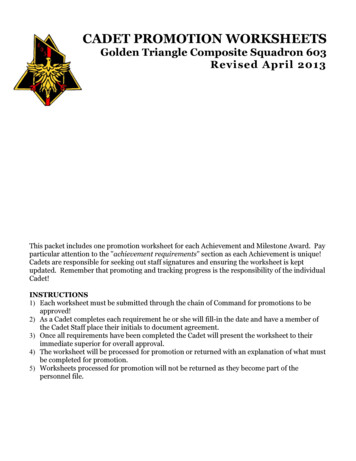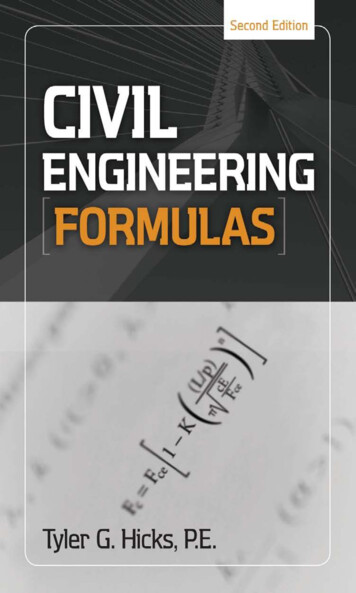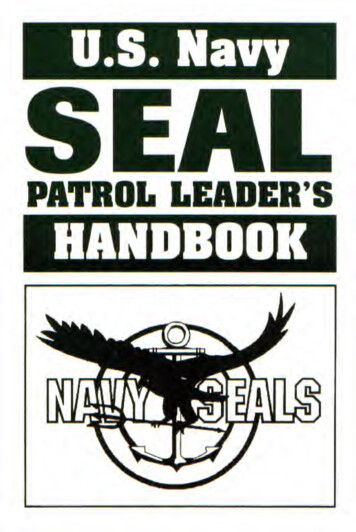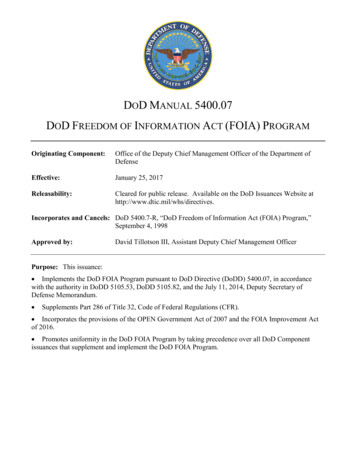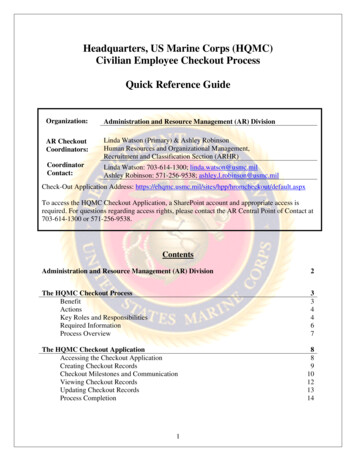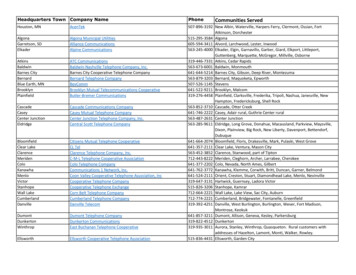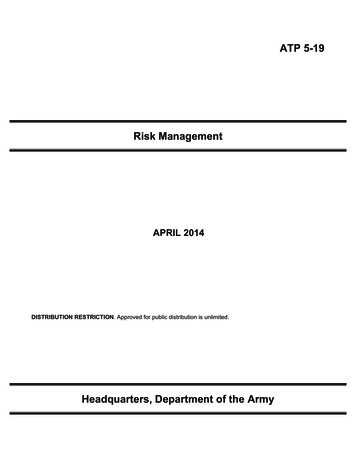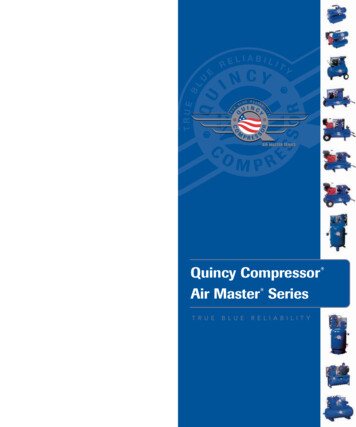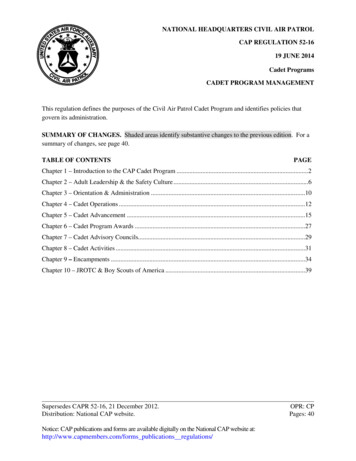
Transcription
NATIONAL HEADQUARTERS CIVIL AIR PATROLCAP REGULATION 52-1619 JUNE 2014Cadet ProgramsCADET PROGRAM MANAGEMENTThis regulation defines the purposes of the Civil Air Patrol Cadet Program and identifies policies thatgovern its administration.SUMMARY OF CHANGES. Shaded areas identify substantive changes to the previous edition. For asummary of changes, see page 40.TABLE OF CONTENTSPAGEChapter 1 – Introduction to the CAP Cadet Program .2Chapter 2 – Adult Leadership & the Safety Culture .6Chapter 3 – Orientation & Administration .10Chapter 4 – Cadet Operations .12Chapter 5 – Cadet Advancement .15Chapter 6 – Cadet Program Awards .27Chapter 7 – Cadet Advisory Councils.29Chapter 8 – Cadet Activities .31Chapter 9 – Encampments .34Chapter 10 – JROTC & Boy Scouts of America .39Supersedes CAPR 52-16, 21 December 2012.Distribution: National CAP website.Notice: CAP publications and forms are available digitally on the National CAP website at:http://www.capmembers.com/forms publications regulations/OPR: CPPages: 40
2CAPR 52-16 19 JUNE 2014CHAPTER 1INTRODUCTION TO THE CAP CADET PROGRAM1-1. Supplements & Waivers. Supplements and waivers to this regulation are not authorized,except as specifically noted, or when approved by National Headquarters. To request waivers to thisregulation, submit requests through the chain of command to NHQ/CP.1-2. Mission. The Cadet Program transforms youth into dynamic Americans and aerospace leaders.CAP accomplishes its Congressionally-mandated Cadet Program (Title 36, U.S.C. 40302) through acurriculum of leadership, aerospace, fitness and character. The program follows a military model andemphasizes Air Force traditions and values. Today’s cadets are tomorrow’s aerospace leaders.1-3. Key Traits of Cadet Life. Five key traits of cadet life inform commanders on the desired look andfeel of cadet activities and how they should conduct the Cadet Program.a. The Uniform. CAP promotes teamwork and high standards of personal conduct by grantingcadets the privilege of wearing an Air Force-style uniform. The uniform and the related traditions ofrendering military customs and courtesies distinguish cadets from ordinary youth. These military aspectsof cadet life are important motivators. Every activity should allow cadets to wear their uniform andproperly render military customs and courtesies.b. Aerospace Theme. CAP members often hold in common a love of flying. Aviation is the threadthat runs through all three CAP missions, and CAP’s affiliation with the Air Force underscores its identityas an air-minded organization. Whenever possible, every cadet activity should further cadets’ enthusiasmfor aerospace, as “aerospace” is broadly understood. With a little imagination, even fitness and characteractivities can be shown to have an aerospace connection.c. Opportunity to Lead. CAP develops leadership skills in cadets by giving them opportunities tolead. This includes planning events, making decisions, and teaching and mentoring junior-ranking cadets,depending on how far the cadet-leaders have advanced in their program. The cadets’ grade structure andmilitary-style chain of command reinforces this leadership concept. Every activity should allow cadetsopportunities to lead, under adult leader supervision.d. Challenge. CAP challenges youth. It might be the physical challenge of conquering an obstaclecourse, an academic challenge to master aerospace and leadership concepts, a moral challenge to live theCore Values or a personal challenge to know oneself better and gain self-confidence. Because of thesechallenges, the Cadet Program is intended for young adults, not children. Every activity should challengecadets in one way or another.e. Fun. CAP is supposed to be fun. New friends and great opportunities are the hallmarks of cadetlife. The cadets who work hard in CAP reap the most benefits, but the program should not be anotherform of school – it needs to be fun, hands-on, rewarding and exciting. Proper adult supervision, a prosafety attitude, and teamwork built upon mutual respect keep cadet life enjoyable. Every activity shouldbe fun, for cadets and their adult leaders alike.1-4. Cadet Oath. A cadet oath serves as a training aid and states how cadets pledge to approach thechallenges of cadet life. The CAP Cadet Oath is as follows:“I pledge that I will serve faithfully in the Civil Air Patrol Cadet Program, and that I will attendmeetings regularly, participate actively in unit activities, obey my officers, wear my uniform properlyand advance my education and training rapidly to prepare myself to be of service to my community,state and nation.”1-5. Program Setting. Cadets experience the Cadet Program through a community- or school-basedunit. A community-based unit has no formal connection to a school, relying upon the community at large
CAPR 52-16 19 JUNE 20143to support it. A school-based unit is formally affiliated with a public or private school and has beenassigned an 800-series unit charter number. Regardless of setting, there is only one Cadet Program; allcadet units use the same curriculum and operate in accordance with this regulation.1-6. Cadets Temporarily Living Abroad. Cadets who will be living overseas and wish to remainactive in CAP may join an overseas unit. If an overseas unit is not available at the cadet’s location,National Headquarters may allow the cadet to progress through independent study, on a case-by-casebasis. Independent study is available only to cadets who will be living abroad.1-7. Program Elements. To fulfill its mission, the Cadet Program is organized around four mainprogram elements: leadership, aerospace, fitness and character. A fifth element – activities – offers cadetsa venue for putting the four main elements into practice. To advance in their program and earn awards,cadets must complete one task for each program element per achievement, with some exceptions. Seechapter 5 for details.a. Leadership.(1) Goal. The goal of the Cadet Program’s leadership element is to develop in cadets the abilityto think independently and lead others in an atmosphere of teamwork and mutual respect.(2) Methods. CAP introduces youth to Air Force perspectives on leadership through self-pacedstudy, classroom instruction and hands-on opportunities to apply leadership principles to real-worldchallenges. Adult leaders, acting as mentors and instructors, help the cadets develop their leadershippotential. Cadets use the Learn to Lead textbook series and AFMAN 36-2203, Drill and Ceremonies, astheir main resources for completing promotion requirements. Furthermore, cadets must wear the uniformproperly (see CAPM 39-1, Civil Air Patrol Uniform Manual).(3) Test Instruments. Cadets must pass multiple-choice tests of their leadership knowledge tocomplete most achievements and earn milestone awards (see chapter 2). Some tests require cadets toperform drill and ceremonies. Achievement 8 and the Eaker Award include a speech and essay assignment.Cadets’ achievements in the Staff Duty Analysis program are measured through reports and staff service,as explained in 5-10b and 5-11b and in CAPP 52-14, Staff Duty Analysis Guide.b. Aerospace.(1) Goal. The goals of the Cadet Program’s aerospace element are to inspire in youth a love ofaviation, space and technology; provide them with a foundation in aerospace’s scientific principles; andintroduce them to aerospace career opportunities.(2) Methods. CAP introduces cadets to aviation, space and technology through self-study andgroup-study methods.(a) Textbook Instruction. Cadets study the Aerospace Dimensions modules (any edition)during Phases I and II of the Cadet Program, and the Aerospace: The Journey of Flight text (any edition)during Phases III and IV. Adult leaders and experienced cadets act as aerospace instructors and mentors.(b) Hands-On Learning. Cadets also have opportunities for hands-on learning through themodel rocketry, Satellite Tool-Kit and Aerospace Excellence (AEX) programs (seecapmembers.com/library for links to these resources). AEX provides local leaders with a hands-onaerospace activity program that is educational, fun and gives cadets the opportunity to learn more aboutaerospace and STEM-related subjects (Science, Technology, Engineering and Math). Each unit that hascadets will conduct at least one AEX activity per quarter. Local leaders can order a copy of the AEXmodules free through eServices. For details on the AEX program and the related AEX Awards Program,please see CAPP 15, Aerospace Education Officers' Handbook. Additionally, cadets may experienceflight through orientation flights (see 8-8).(3) Test Instruments. Cadets must pass a multiple-choice test of their aerospace knowledge formost achievements (see CAPVA 52-100, Cadet Super Chart). The Mitchell, Earhart and Spaatz Awardexams also test cadets’ aerospace knowledge.
4CAPR 52-16 19 JUNE 2014c. Fitness.(1) Goal. The goal of the Cadet Program’s fitness element is to develop in cadets a habit ofregular exercise.(2) Methods. The fitness program encourages units to provide drills, games and other activitiesthat promote physical fitness. Effective 1 September 2014, commanders will schedule time for cadetfitness training; simply administering the fitness tests described below is not sufficient (see CAPP 52-18,Cadet Physical Fitness Program, for suggested activities). Physical exercise in the Cadet Program willbe used only to improve cadets’ physical fitness while increasing confidence, teamwork anddetermination. Fitness training will not be used as a form of punishment or as a vehicle to teach remedialdiscipline.(3) Test Instruments. As new cadets join CAP, unit commanders assign them to the appropriatephysical fitness category, as explained in 2-10. CAP expects each cadet to exercise regularly andparticipate in the unit’s physical fitness program. For details on the Cadet Physical Fitness test, see 5-7.d. Character.(1) Goal. The goal of the Cadet Program’s character element is to develop in cadets an abilityto think critically about moral and ethical issues, and the commitment to live CAP’s Core Values.(2) Methods. CAP develops character in cadets through mentoring, character development andactivities that promote a drug free ethic.(a) Mentoring. Through formal and informal mentoring, cadets have opportunities tolearn from close, trusted, experienced advisors. The cadet chain of command reinforces the concept thatranking cadets have a responsibility to mentor their juniors, as adult leaders have a responsibility tomentor the ranking cadets. Mentoring and character development are ongoing, open-ended facets of theCadet Program.(b) Character Forums. Unit commanders will provide a character development programfor cadets, using the resources found at capmembers.com/character. A CAP chaplain or characterdevelopment instructor (CDI) will coordinate the program. In units without a chaplain or CDI, thecommander may temporarily lead character forums, but must endeavor to recruit a chaplain or CDI assoon as possible. During character forums, cadets examine moral and ethical issues, but the forums arenot religious meetings.(c)Drug-Free Activities. CAP challenges all cadets to become ambassadors of the drugfree ethic. See CAPR 52-22, Drug Demand Reduction Program, for details.(3) Evaluation Instruments. Cadets are evaluated informally, as the senior memberconducting character forums monitors the degree to which each cadet is participating in the activity.More importantly, leaders observe cadets’ overall conduct and outward signs of moral character. Thecadets’ adherence to the Core Values is discussed during leadership feedback meetings (see 5-2c).e. Activities.(1) Goal. The goals of the Cadet Program’s activities element are for cadets to apply theirleadership skills, explore aerospace careers and display their overall enthusiasm for the cadet ethic.(2) Methods. Each unit decides what activities it undertakes based on the interests of its leadersand members. All units must strive to be well-rounded and offer activities encompassing all three CAPmissions. The cadet staff helps plan and lead unit activities. Cadet activities should be “hands-on,”enabling cadets to apply what they have learned in the other four program elements. Activities may beconducted locally, regionally and at the national level. All activities must emphasize safety (see chapter2) and require planning to succeed (see 4-3). Units may establish an activities committee to help managecadet events. In Phases III and IV, cadets serve as mentors and instructors, respectively, helping juniorcadets advance in leadership, aerospace education or physical fitness.
CAPR 52-16 19 JUNE 20145(3) Evaluation Instruments. Each activity must have an educational or training goal and atleast one objective that is specific and measurable, but there is no standard, formal test instrument for cadetactivities. However, commanders should seek feedback from cadets and staff on ways to improve localactivities. For major events, activity directors must provide their commander with an "after action report"that discusses the activity's successes and lessons learned. These reports are kept in a continuity file toaid in the planning of future activities.1-8. System of Achievements. Through study and performance, cadets work through a series of sixteenachievements and five milestone awards. Generally, cadets must complete one task in each programelement to complete each achievement or award (this principle varies – see chapter 5). Further, eachachievement and award is grouped into one of four phases. As cadets progress, they advance in grade,increase the scope of their leadership responsibilities, earn awards and become eligible for nationallysponsored activities and scholarships. CAPVA 52-100 illustrates the Cadet Program’s system ofachievements.
6CAPR 52-16 19 JUNE 2014CHAPTER 2ADULT LEADERSHIP & THE SAFETY CULTURE2-1. Cadet Protection Policy. CAP operates in accordance with a Cadet Protection Policy, to keepcadets safe from physical, sexual, and emotional abuse and hazing. See CAPR 52-10, Cadet ProtectionPolicy, for details. CAPR 52-10 also discusses when activities require a parental permission slip, andrequirements to announce activities in advance.2-2. Adult Supervision. Adult CAP members support cadets as mentors, instructors, supervisors,chaperones and in countless other roles. The success of a cadet unit is largely a function of the quality ofthe adult leadership.a. Role of Adult Leaders. Detailed position descriptions for the senior staff are suggested in CAPP216, Cadet Programs Specialty Track Study Guide. CAPP 52-15, Cadet Staff Handbook, also discussesthe adult/ cadet leadership relationship.b. Adult Leader Definition. CAP has a number of membership categories available to adults whoserve in a supervisory and mentoring role over cadets. The term “adult leader” is used in this regulationas shorthand for all members who supervise cadets, but the term does not include cadet members.c . Leadership for Safety. A critical duty of adult leaders is to keep cadets safe by monitoring theirconduct, following operational risk management (ORM) principles and exercising sound judgment. Unitcommanders will take all reason-able measures necessary to protect cadets from harm while under CAPsupervision. See CAPR 62-1, CAP Safety Responsibilities and Procedures, and capmembers.com/orm forguidance.d. Cadet Sponsor Members. Cadet Sponsor Member (CSM) is a membership category allowingparents, grandparents, and guardians of current cadets to assist their unit’s cadet program. CSMs may serveas chaperones, help with transportation, and support the Cadet Program at the unit commander’sdiscretion. For further details, see CAPR 39-2, Civil Air Patrol Membership.e. Standard of Training. Because no cadet unit can succeed without adult leadership, every cadetunit shall have at least two graduates of the Training Leaders of Cadets (TLC) course assigned by 1 April2015 (see 2-3a). Wings are responsible for providing extra mentoring to units that are in non-compliance.Wing and region directors of cadet programs should be TLC graduates.2-3. Adult Professional Development. The principal way for adult leaders to become effectiveleaders of cadets is via the Cadet Programs Officer specialty track in the Senior Member ProfessionalDevelopment Program. See CAPP 216 and CAPR 50-17 for details.a. Training Leaders of Cadets. TLC is the centerpiece of the Cadet Programs Officers’ specialtytrack. It prepares adult leaders to lead cadets at the unit level. TLC is administered at the group level orhigher and should be offered at least once per year in each wing. The commander of the host echelonselects the course director, who should possess a master rating in the Cadet Programs Officer specialtytrack. To foster a learning environment that encourages open discussion among adults, cadets areprohibited from participating in TLC. Students must complete 80% of the course to graduate. For coursematerials and other program details, see capmembers.com/tlc.b.Required Staff Training. The Required Staff Training (RST) course is a program foradult leaders and ranking cadets that focuses on leadership challenges at lengthy cadet activities. Cadetsand adults who serve on the staff of an encampment, national cadet special activity, region cadetleadership school or a similar cadet activity lasting 4 nights in duration or longer or at any other cadetactivity designated by the wing commander, will complete the RST in accordance with CAPP 52-12,Required Staff Training.
CAPR 52-16 19 JUNE 201472-4. Policy on Drugs & Supplements.a. Prescription Medication. The administration of both legal prescription and legal nonprescription medication(s) is the responsibility of the CAP member and not the CAP Corporation. Theauthority for members who have reached the age of majority to bring legal medications to CAP activitiesis vested with that member. The authority for members who have not reached the age of majority tobring legal medications to CAP activities is vested with that member’s parent or legal guardian.b. Energy Drinks. Energy drinks are dietary supplements containing high doses of caffeine and/orother stimulants. Popular brands include Red Bull, Monster, Rockstar, etc. Because the U.S. Departmentof Health and Human Services warns that energy drinks are hazardous to teens, cadets are prohibited fromconsuming energy drinks at CAP activities.c. Recreational Drugs. Cadets will not possess nor use any drugs that are prohibited under federallaw, even if local law permits their use. Further, tobacco products and e-cigarettes are prohibited forcadets at CAP activities.2-5. Training in Hot Environments. For all cadet activities, commanders will adhere to the fluidreplacement and work load limitations described in CAPP 52-18.2-6. Operational Missions. Cadets may participate in emergency services missions, provided that theymeet
Cadet Programs . CADET PROGRAM MANAGEMENT . This regulation defines the purposes of the Civil Air Patrol Cadet Program and identifies policies that govern its administration. SUMMARY OF CHANGES . Shaded areas identify substantive changes to the previous edition. For a summary of changes, see page 40. TABLE OF CONTENTS PAGEFile Size: 318KB

